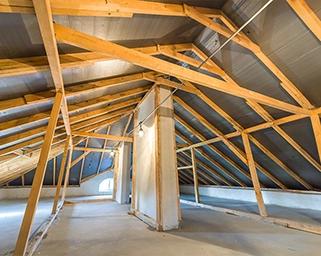How Can Crawl Space Insulation Affect My Energy Bills?
Learn how crawl space insulation or crawl space encapsulation can help increase your comfort, improve your indoor air quality, and lower your energy bills.
By Anne Fonda
As we recently wrote in our blog on weatherization, insulating your home can help decrease your energy consumption and enable your HVAC system to work more efficiently. This in turn can reduce your energy bills.
A sometimes neglected area of your home is your crawl space. But by insulating or encapsulating your crawl space, you can save on your energy bills and feel more comfortable at the same time.
What happens with an unsealed or poorly insulated crawlspace
An unsealed or poorly insulated crawlspace allows moisture, humidity, hot air, and cold air into your home through your floor. This is especially common in older homes. In the winter, cold air in the crawlspace can make your home feel cold. In the summer, humid air can make your home feel sticky, and even cause mold and mildew growth.
Insulating or encapsulating your crawl space can increase your comfort by reducing the humidity level and making it easier for your HVAC system to heat and cool your home.
Crawl space encapsulation
Crawl space encapsulation is slightly different than crawl space insulation. For optimal energy savings and pest control, you may want to consider both.
Crawl space encapsulation is recommended for when you have water/moisture issues in the crawl space such as standing water after a rain. It would start with drying out your crawl space and removing damaged insulation.
It can include sealing leaks, installing a vapor barrier on the floor and walls, installing a drainage system with a sump pump, grading around your foundation walls, adding a dehumidifier, and more.
To get the job done right, hire a local company experienced in these types of jobs in tight quarters. They will also follow local building codes and regulations.
Insulating your crawl space
Using the right crawl space wall insulation is critical. Concrete foundation walls need a closed cell spray foam insulation that is water resistant.
Batt fiberglass insulation between the floor joists is not recommended because it absorbs moisture. If it is installed, it needs to be covered with rigid foam board insulation, and the bard seams would need to be taped. Blown-in insulation is also not suitable for a crawl space for the same reasons.
Every crawl space is different, and we would recommend working with a professional trained in crawl space insulation and encapsulation.
What about my crawl space vents?
Building codes may require crawl space vents but building professionals now realize that an unvented crawl space, or closing the vents is a better practice. Leaving the vents open in the winter lets in cold air and leaving them open in the summer can cause humidity issues in the home.
Vents should be closed and sealed during the encapsulation/insulation process for maximum comfort and energy savings.
Energy savings from insulating your crawl space
According to the Environmental Protection Agency (EPA), the average heating and cooling savings after insulating is 15%. Savings can be higher in the North than in the South due to climate factors.
But you must do it right. Adding the wrong type of insulation or not dealing with moisture issues can cause sopping wet insulation and/or mold growth.
Claim a tax credit for your efforts
Both insulating a crawl space and crawl space encapsulation are projects that are eligible for an insulation tax credit. It’s part of the Inflation Reduction Act of 2022 series of energy-efficient home improvement tax credits and heat pump rebates designed to help homeowners make their homes more energy efficient.
This credit is for 30% of the cost of the project materials – not labor. The maximum tax credit for an insulation project is $1,200 per year until 2032. So, you don’t have to stop with the crawl space. You could upgrade the insulation in your garage or attic as well.
Include a sealed, conditioned crawl space when building a new home
If you’re building a new home with a crawl space, spend the extra money now to insulate and possibly encapsulate it. It will keep your home more comfortable and enable your HVAC system to work more efficiently for years to come, saving you potentially thousands of dollars over the years.
ENERGY STAR® has some great recommendations for sealing and insulating your crawl space.
The bottom line
An insulated crawl space can help increase your home comfort and reduce your monthly energy bills. Any insulation upgrades to your home, including replacing drafty doors and windows can decrease your energy costs because you’re not letting as much outside air in or conditioned air out.
Get more energy savings information.
If you want to improve your indoor air quality or upgrade your HVAC system, we can help. Contact your local Trane dealer to set up a consultation.
Anne Fonda, Content Writer
A Content Writer with Trane Technologies, Anne Fonda researches topics and writes for Trane® and associated residential HVAC brands. She works in collaboration with Trane Technologies subject matter experts, offering easy-to-understand, informative content on complex topics. Her goal is to help consumers make informed decisions on the products and services they need.
She has written for HVAC and other service provider websites for over 16 years. Before transitioning to web content writing, Anne had a 14-year stint as an award-winning journalist. She graduated cum laude from the University of Missouri-Columbia School of Journalism.
When she’s not working, Anne enjoys playing word games, reading, gardening, spending time with family, and visiting gardens and museums.
Expert review by Kimberly Sexton, Senior Systems Engineer




